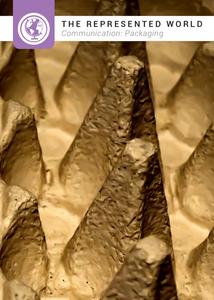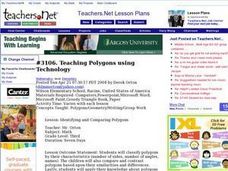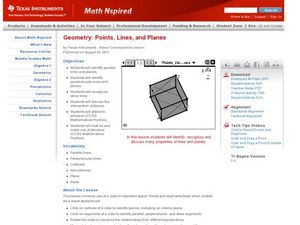Curated OER
Pyramids and Prisms: Guler's Formula
Sixth graders detect and categorize the attributes of geometric shapes to solve problems. In this geometry lesson, 6th graders construct a variety of polyhedra. Students recognize the relationships between two dimensional and three...
Curated OER
Geometry Exam
In this reflections and symmetry activity, students draw lines of symmetry in shapes and patterns and reflect letters over lines in graphs. Students complete 20 problems.
Curated OER
Introducing Powers and Models
Young scholars construct two dimensional models to illustrate squared numbers. For this geometry lesson, students use graph paper and an x/y axis to build squares exponentially. Young scholars identify powers and relationships between...
Curated OER
Buttons, Buttons, Everywhere!
Students compare, sort, and describe shapes. Using a button collection, students identify the shape, color number of holes, etc. Students play a description game with the buttons. They create a chart and name items that are the same...
Curated OER
Patterns Here, There, and Everywhere!
Upper graders access the Microsoft Word program and create patterns by utilizing certain keys on the keyboard. They create picket fences, smiley faces, and hearts. It seems that this lesson has as much to do with keyboarding skills as it...
Curated OER
Geometry
In this congruent figures worksheet, students analyze a geometric shape and choose from the answer box any figures that are congruent to that shape. There are 3 problems.
Curated OER
Geometry Assessment: Solid Figures
In this geometry assessment worksheet, students match the drawing of two faces of the solid to the name of the solid for six geometric figures.
Curated OER
Lesson 9-3 Practice A: Composite Figures
In this composite figures worksheet, students solve twelve short answer problems. Students find the area of figures composed of various polygons given a sketch of the figure with side lengths labeled.
Curated OER
Making a Six-pointed Star
In this polygon worksheet, students identify and create a six-pointed star by completing 6 steps. First, they use a compass to trace a circle with a given radius. Then, students draw a point on circumference of the circle and place the...
National Security Agency
Backyard Building - Area and Perimeter
Turn young mathematicians into landscape architects with this four-lesson series on area and perimeter. Beginning with a basic introduction to calculating perimeter and area using non-standard units of measurement, this...
Indiana Department of Education
The Represented World: Communication—Packaging
Challenge your classes to design and market a new product. Collaborative groups use geometry skills to create packaging for their products. Finally, they plan a marketing strategy to present to a marketing specialist.
Curated OER
Mandalas, Polygons and Symmetry
Students create a geometric pattern using mandalas, polygons and symmetry. In this geometry instructional activity, students analyze the mathematics involved in making the mandalas, including the shapes and symmetry. Students create...
Curated OER
Exploration with Geometric Solids
Students reinforce geometric concepts by playing "Guess My Solid." Through a process of elimination, they determine the shapes of mystery solids. Finally, students use various materials to construct their own geometric figures.
Curated OER
Polygon Sum Conjecture
In this geometry worksheet, 10th graders identify the missing angles using the polygons sum conjecture. They measure exterior and interior angles using their angle theorems. There are 63 problems.
Think Map
Know Your Polygons!
Shape shifters recognize characteristics of polygons. Embracing language arts skills in addition to math, they use a thesaurus to pinpoint specific attributes of a set of polygons. They also participate in a 21-question guessing game...
Curated OER
Teaching Polygons using Technology
Third graders utilize different types of computer programs, such as Microsoft paint and Microsoft Word to study and create different types of polygons. They use PowerPoint to create a story about a shape and others that it meets during a...
Curated OER
Building Blocks of Geometry
In this geometry worksheet, students answer questions about midpoints, distance, lines and segments. They are given different shapes and asked to calculate the angles, and sides of polygons.
Curated OER
Exploring Area and Perimeter
Two students are blindfolded and each receives a cardboard square, one with pompoms glued around the edge and one with pompoms glued all over the surface. They identify what they feel. The class discusses perimeter and area of polygons....
Curated OER
Geometric Shapes and Angles
For this geometry worksheet, 10th graders review polygons and solve for the missing angles of trapezoids and isosceles triangles. There are 10 questions on this worksheet with an answer key.
Curated OER
Visualize 3-D Objects and Make Nets of Common Solids
Prisms are the focus of this geometry worksheet. Students count the number of parts of a prism and chart 26 answers. Vocabulary such as: "faces," "edges," and "verticies" are taught. A well-designed math worksheet!
Texas Instruments
Points, Lines, and Planes
High schoolers solve problems dealing with points, lines and planes. In this geometry lesson, students differentiate between parallel lines and planes. They find the intersection of lines and planes.
Mathematics TEKS Toolkit
Grade 6: Exploring c/d = pi
Introduce your math class to the perimeter of a circle. Teach them that pi describes the relationship between the circumference and the diameter. As a hands-on investigation, pairs or small groups use string to compare these two values...
Curated OER
Finding the Area of Regular Polygons
Students analyze relationship between the increase in polygons sides and a circle. In this geometry lesson, students relate the size of the central angle of a polygon, to a circle. They compare the formula for the area of a polygon and a...
Curated OER
Property Lists for Quadrilaterals
Young scholars establish classifications of shapes by various properties (angles, sides, etc.). They introduce the important properties of common shapes. Students develop an awareness of the wide variety of ways the 2-D shapes can be alike.























